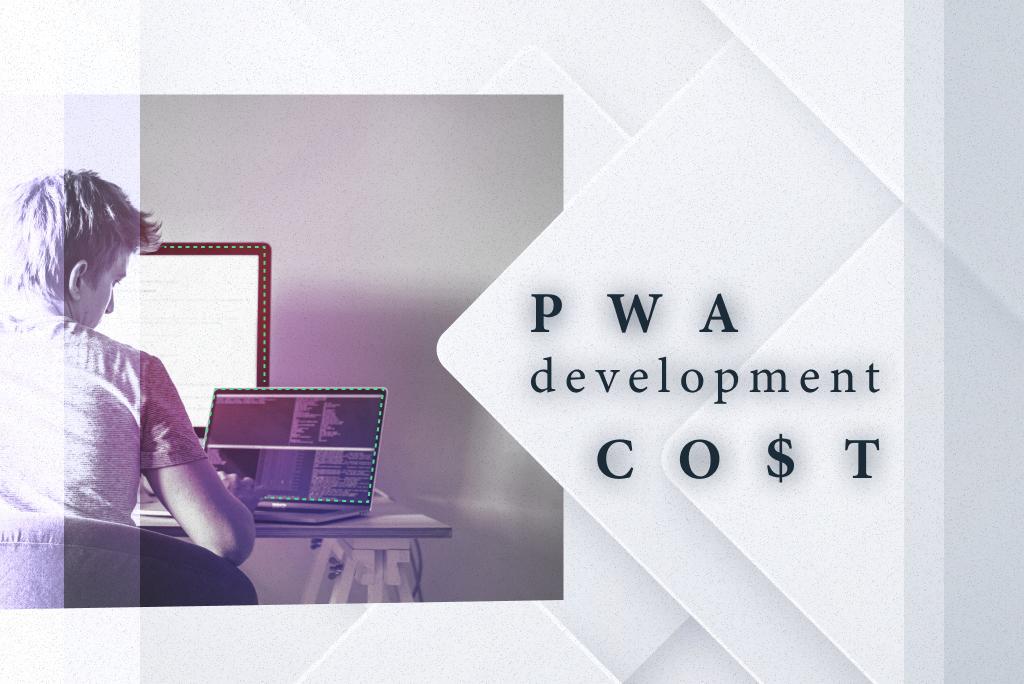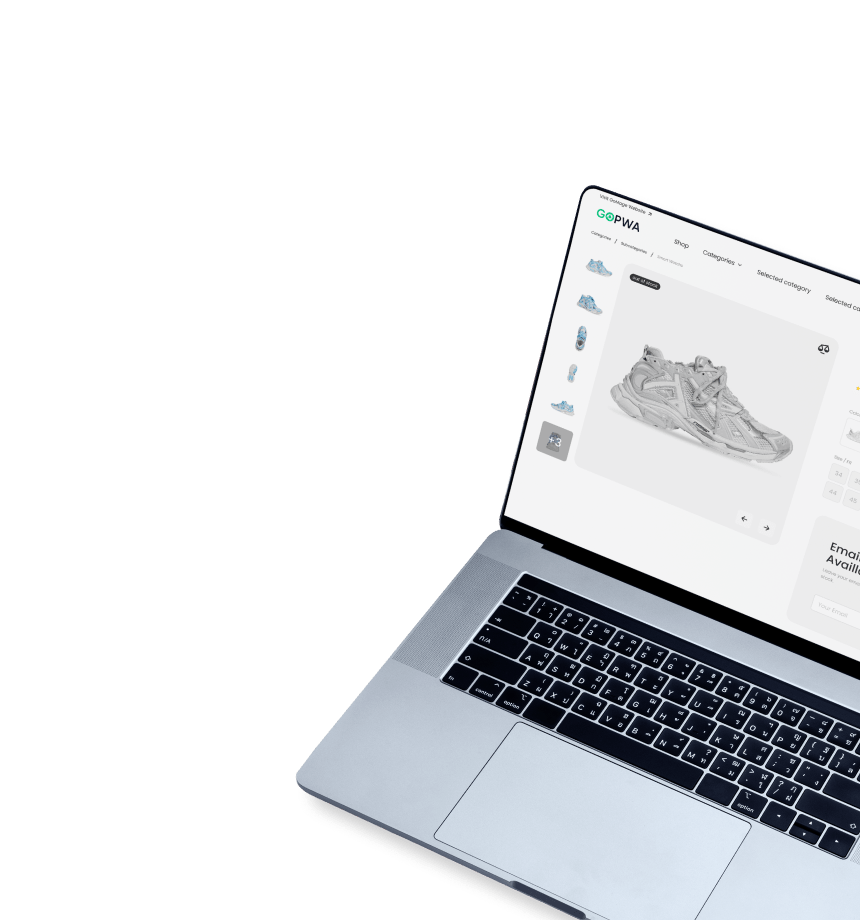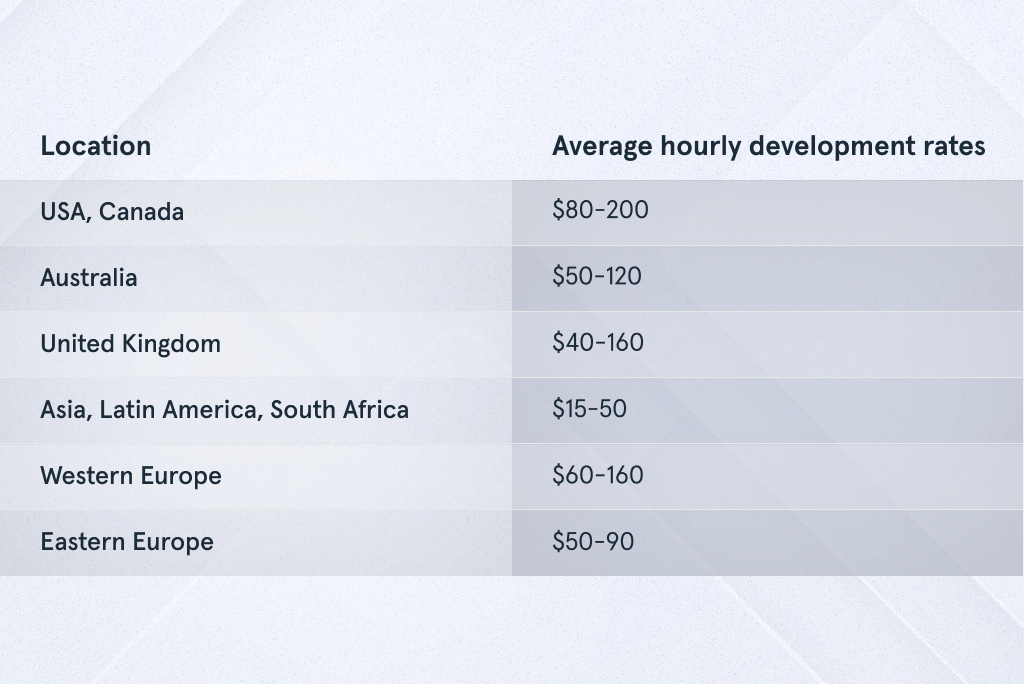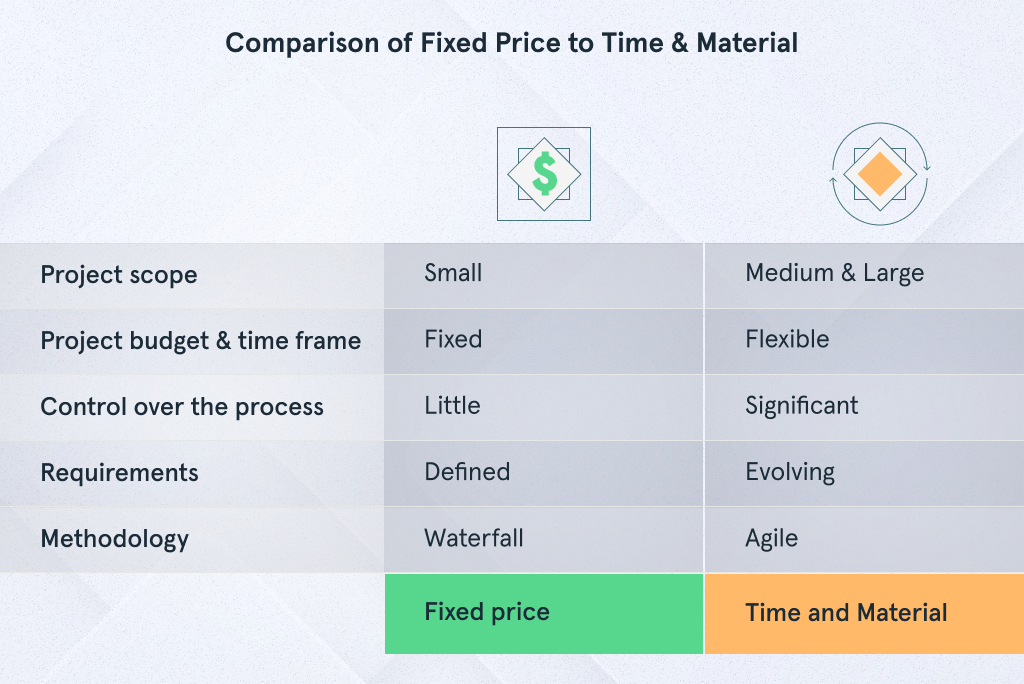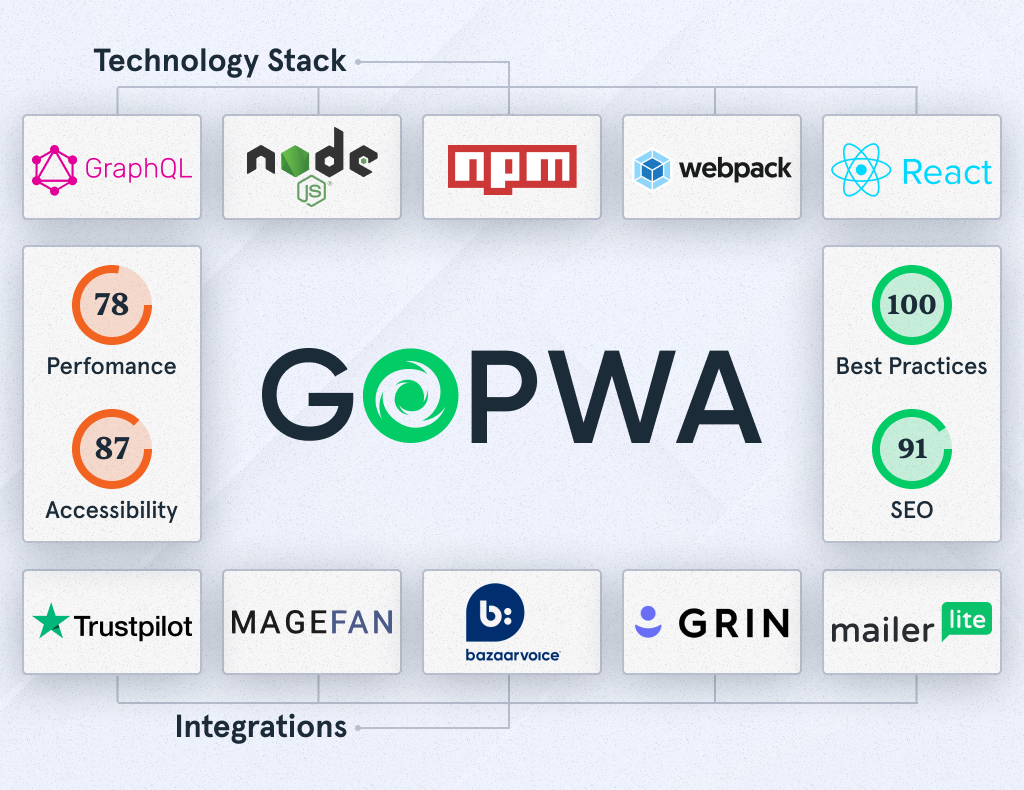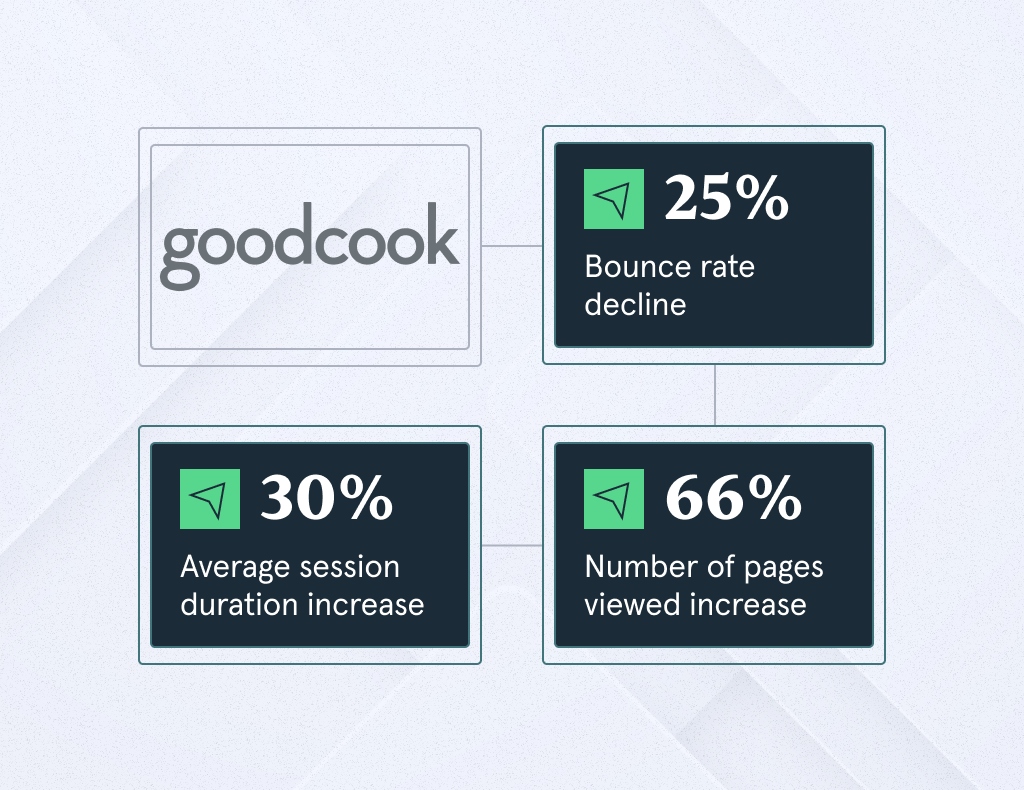So, you’ve decided to build a progressive web application for your eCommerce business.
The decision is well justified by all the benefits of the PWA technology – better conversions, higher ROI, faster development time, better loading times…
When you start exploring the development options, you will get quotes from companies ranging between $10,000-$50,000+.
Why is there such a difference between progressive web app development costs among different companies?
That’s the question we answer in the article. You’ll learn:
- The average progressive web apps cost
- Key factors influencing progressive web app cost
- How GoPWA can reduce the progressive web application development cost
- How not to overpay for eCommerce PWA development
Read on to learn about PWA development costs.
Average Progressive Web App Development Cost
Progressive web application development cost depends on numerous factors. That’s why it’s impossible to provide you with the price without an in-depth understanding of your requirements and project.
Still, the market has an average PWA cost, which usually starts at around $40,000-$50,000.
There are some PWAs that cost less and some that cost millions of dollars.
From our own experience, building a meaningful PWA takes from 2,000 to 2,5000 hours. If we’re talking about some serious customizations and custom eCommerce website design, the numbers can double or even triple.
Modules, customizations, design, and the number of integrations are just a few factors that influence the final PWA development cost.
Continue reading the article to learn more about the cost-forming factors and how to ensure your project won’t go over budget.
Progressive Web Apps Cost: Additional Influential Factors
The complexity of PWA projects varies significantly. Many factors influence the final progressive web apps cost.
To understand how the PWA cost is calculated, take a look at the key influential factors. You’ll learn how one decision can move the cost of PWA development to an entirely new level.
Company You Work With
When you’re building a PWA, you have two options – hiring an in-house development team or outsourcing PWA development to a vendor. Lower costs, higher professionalism, and faster time to market are why many businesses decide to outsource development to a third-party vendor.
If that’s the case with your business, you need to choose the outsourcing location carefully, as all locations have different prices for PWA development. Below is a table providing an overview of average hourly PWA development rates based on different locations.
So, the USA and Canada are the most expensive outsourcing locations while Asia, Latin America and South Africa are the least expensive ones.
However, sometimes companies from the USA or the UK provide services for $50/per hour or less. It may be that the company works with engineers from developing countries and has offices in different locations around Europe. If that’s the case, there is nothing to worry about. Europe is famous for being a trusted development center.
If the company doesn’t have offices in multiple locations, it means that they are outsourcing development to freelancers and other companies. The biggest downside here is having no control or limited control over the code and project quality.
But be cautious when choosing the least expensive vendors. Good talents and mid- or high-quality code cannot cost a few pennies.
While price is important, developers’ skills and professionalism are the most significant factors.
High-level professionals are more expensive but do the job faster with good quality. So, in the end, you save a lot of money. With low-cost freelancers and developers, there is a risk that they are overloaded with tasks, they don’t have enough experience and they won’t follow the best Magento coding practices. As a result, time and money is wasted.
Cooperation Model
Cooperation or pricing model is another factor that influences PWA development cost. Usually, there are two types of models: fixed price and T&M (time and material). Let’s see how they are different.
Fixed price model is when customers pay the contractor for the results at a predetermined and agreed cost. The terms of work, the scope of tasks, deadlines and budget are defined before the work on the project starts.
The only advantage of this model is the fixed cost that you know in advance.
The main challenge of the model is the inability to change anything after the project starts. For example, if you need to make some changes to the requirements, it will cost you additional money. In some cases, you can’t change anything before the project is delivered per predetermined and negotiated requirements.
Also, specialists working within this model usually charge higher. Vendors, trying to meet deadlines, sometimes sacrifice quality not to overspend their resources on your projects.
The fixed model is better suited for simple projects with strict requirements and no possibility of unexpected changes.
Time and material model is when customers pay for the time spent on their project.
Companies working within this model change based on hourly rates. The estimation of the project and deadlines are made approximately. The main goal is the results and high quality of provided services.
The main advantage of the model is flexibility. You can make changes to projects on the go, add new features or make additional customizations. In the end, you’ll pay for the hours that developers and other experts have spent working on your eCommerce PWA project
Project Requirements & Complexity
Project complexity is the main PWA cost-driving factor. The more complex the solution you need, the more expensive it is. Complex projects usually require the involvement of skilled and experienced developers and designers, whose services aren’t cheap.
Also, building a small project with a small product catalog and a few pages, and features of eCommerce websites requires less development time. Less time means less money you’ll need to pay. Large PWA projects can cost millions of dollars to build.
Usually, design and customizations are the main factors that influence PWA development cost. Luckily, you can save thousands of dollars using our GoPWA storefront for Magento.
Want to know more about the GoPWA storefront?
Get in touch with our team to learn more about the fastest PWA storefront on the market and how it can help you save money on PWA development
Get a free consultation
Project timelines
A tight project deadline can also increase progressive web apps cost. The faster you need to deliver the project to the market, the more resources are required for the job. If your deadlines are tight and there is no way you can shift them, choosing a PWA storefront to speed up the development process is one of the possible options. Read on to learn more about it.
Development Approach & Solution
Let’s talk more about the key approaches to the development process. Overall, there are three ways you can go – build a PWA from scratch, use a PWA template and build a custom PWA based on a PWA storefront.
Let’s take a look at the approaches, how they differ and what benefits each brings.
PWA development from scratch
Building a PWA from scratch is a long and complex process. You’ll need to find and hire a company that can build a PWA from scratch based on the provided business requirements.
In the best-case scenario, you’ll need to spend at least 6-9 months building a custom PWA from scratch. Custom development allows you to build a highly customized PWA with a unique design.
At the same time, it entails a huge budget and deep involvement from your side. It’s also quite difficult to create a project backlog with all business requirements. You’ll need to find a vendor that will be able to take the reins of the development process and lead it in the right direction.
Pros:
- Highly customized solution
- A PWA that addresses your needs
- High scalability (if built following the best practices)
Cons:
- Long development process
- High expenses
- Difficult to find a development vendor
- Challenging to take into account all the requirements
- Scalability and reliability issues (if not built right)
Use a PWA template
The use of a PWA template or PWA builder will speed up the development process and potentially reduce the development process. Such builders provide some essential features out of the box, so there is no need to build them from scratch.
Overall, PWA builders are mainly suitable for small businesses with a dozen products in their catalog and simple business requirements.
At the same time, the capabilities of PWA builders are limited and unable to meet the requirements of medium and big-scale eCommerce businesses. If you have some unique requirements or run a big business, PWA builders might be unable to do the job right. Sooner or later, you’ll hit the point when its capabilities aren’t enough for your growth. In such situations, you’ll need to move to another platform or rebuild your PWA from scratch, which will cost you even more money.
Pros:
- Faster time to market
- Lower initial investments
- Out-of-the-box features
Cons:
- Limited number of PWA builders on the market
- Limited capabilities and functionality
- Scalability and reliability issues
- Dependent on the builder provider
- Now suitable for large-scale projects
- Difficult to find developers specialized in PWA builders
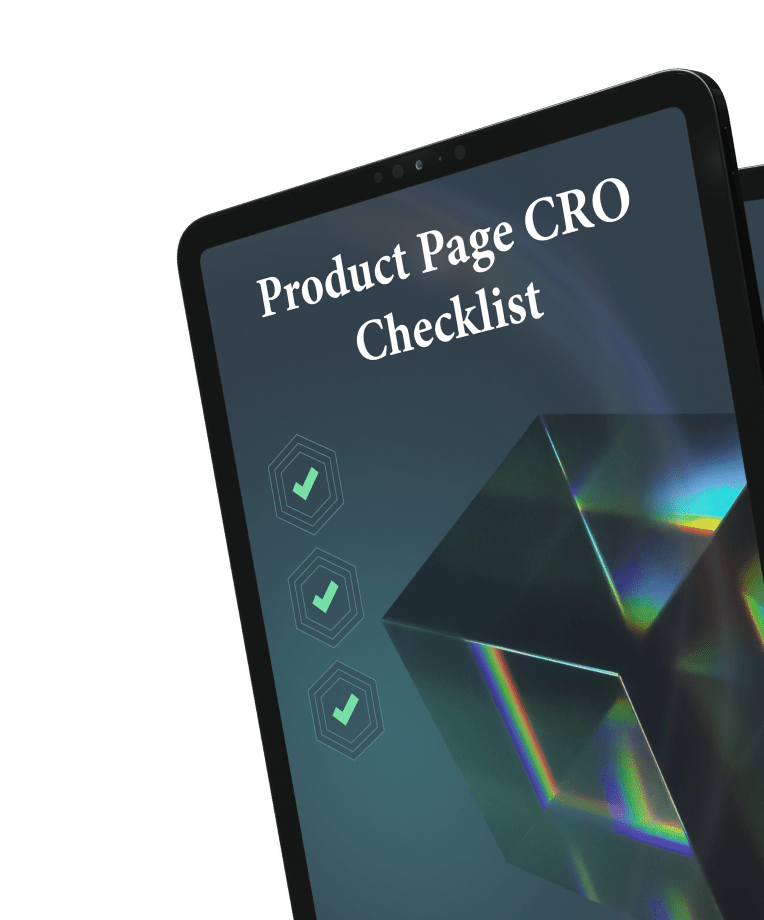
Custom PWA development based on a storefront
This is the option that provides the best time to market and cost of developing a progressive web application. Some PWA storefronts – like GoPWA – provide unlimited customization capabilities and a vast number of out-of-the-box features and integrations.
Pros:
- Huge customization capabilities
- Fast time to market and ROI
- Suitable for businesses of all sizes
- Unlimited scalability
- Fully meets business needs & requirements
Cons:
- Challenging to select a suitable solution among competitors
- Issues with finding developers (if the solution is built on some rare technology)
Let’s discuss how you can minimize the development cost and time with GoPWA Storefront.
How GoPWA Storefront & GoMage Can Reduce Development Cost & Time
GOPWA was developed based on Magento PWA Studio. You receive both standard PWA Studio features and special ones designed by our team. We provide 45+ integrations, a one-click installer, complete control over storefront settings, and blazing-fast performance right out of the box. But those aren’t all the advantages.
GoPWA Storefront wins among competitors in a few areas – scalability, performance, customization capabilities, number of integrations, development cost, and time to market.
You can see below in the image demonstrating some results that our client got after implementing PWA. It took us less than 5 months to turn a WordPress blog into a full-fledged eCommerce PWA thanks to the use of GoPWA.
By allowing full adjustment of storefront elements from the admin panel, we designed GoPWA to reduce the development effort. The development team can configure all the necessary features directly from the admin panel, shortening the time to market.
Here’s a quick look at the key features provided out of the box:
- Import/export configuration
- Widgets styling via Tailwind from the admin panel
- Dynamic Page Builder for editing your webstore
- Pre-configured and ready-to-use widgets and layouts
- Unlimited customization capabilities
- PWA that is in the green zone on PageSpeed Insights
We also provide over 45 integration and a few more available in the GoPWA store:
- Marketing integrations: TrustPilot, MageFan, MailerLite, Grin
- Tracking & analytics: Google Tag Manager, Google Analytics, Awin, Hotjar
- Payment methods: PayPal, Braintree, Adyen, Afterpay, Cybersource
- Search options: ElasticSearch, Klevu, Algolia, Adobe Live Search (partial support for Adobe Commerce only)
If you decide to build a PWA with GoPWA, you’ll need to make a one-time payment of $1,799 and further build a PWA yourself or hire a third-party company for customization. You’ll get the storefront for free if you choose to work with GOMAGE as your development vendor.
You might be interested in collaborating with GOMAGE on your eCommerce PWA for the following reasons:
- The GoPWA team contributes to the client’s projects as well. Our company has over 11 years of experience in Magento eCommerce development. The GoPWA team needs less time for development and customization because they are well-versed in the storefront. Your development check will consequently be much lower.
- We are able to add new features and integrations, as well as modify current ones, to the PWA as needed.
- Even with the largest product catalogs and functionalities, GoMage makes sure that eCommerce PWA operates without any performance difficulties.
The admin panel also gives you complete control over the content, saving you dozens of development hours. No need to rush to the developers each time a new page is launched or a page is made for marketing objectives. Even users who lack technical expertise can design and customize pages using drag-and-drop page builders.
GoPWA works both with Adobe Commerce and Magento Open Source, which allows you to save on Magento cost.
As GoPWA provides a lot of features out of the box, you’ll be able to save thousands of development hours and, consequently, hundreds of thousands of dollars on PWA development.
Want to know how much your project will cost if built with GoPWA?
Get in touch with our team to get a free project estimate. We’ll calculate how much time and money it’ll take to build your project.
Get a free project quote
Progressive Web Apps Cost: Key Takeaways
As you can see, PWA web apps costs vary significantly. The final cost you’ll need to pay will depend on the project complexity, customizations, the solution and development approach you choose and even the development vendor you hire.
Regardless of the solution you decide to choose, there are a few recommendations that will help you avoid overpaying for PWA development:
- Create a design brief for your project.
- Make a list of requirements to the outsourcing vendor.
- Make sure to precisely define your project idea before beginning to look for a contractor.
- List all of your requirements.
- Create a precise design specification.
- Carefully approach the process of finding a PWA development vendor. Examine all available companies. Compare costs, conditions of service, etc.
- Once a contractor has been selected, decide on communication channels.
- Don’t pass up the chance to talk about problems throughout the design and development phase. Once product development is complete, bug fixes will be far more expensive.

